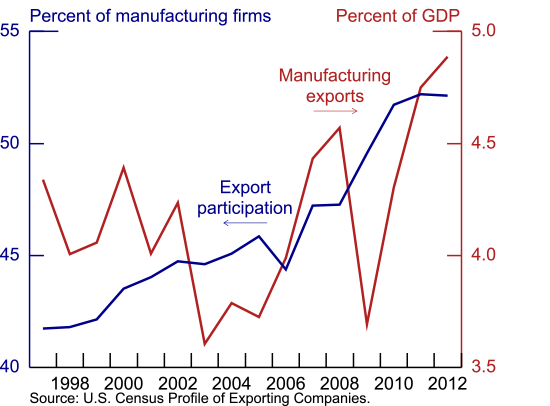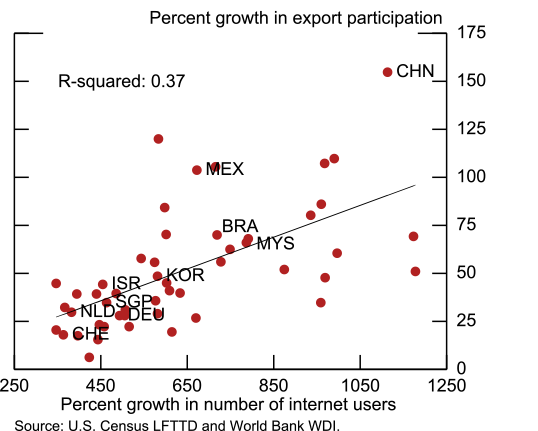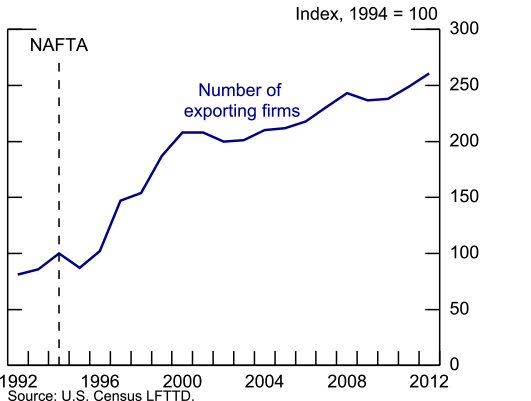IFDP Notes
February 2, 2016
The Rise of Exporting by U.S. Firms
William F. Lincoln1 and Andrew H. McCallum 2
Introduction
Over the last few decades global trade has expanded significantly, both in terms of the volume of trade as well as the number of varieties of goods traded across countries. Many economists argue that one of the most important channels through which international trade increases consumer welfare is by expanding the set of goods accessible to consumers. Therefore, increases in the number of firms exporting, and the associated growth in the number of varieties of goods traded, has likely had a significant impact on welfare worldwide.
In this note, we summarize the motivation and results of Lincoln and McCallum (2015), which investigates the factors supporting globalization by focusing on the experience of the United States.3 Along with the well-known expansion of export volumes, we document a significant increase in the prevalence of U.S. firms selling abroad. Using a firm level dataset and empirical model to identify the key determinants of U.S. firms' participation in export markets, we uncover that the development of the internet, new trade agreements, and growth in foreign income were important forces behind increased export participation. Declines in barriers to entry, exchange rate movements, and the fall of the Soviet Union, in contrast, all played small roles. In so doing, we provide a better understanding of the factors giving impetus to the recent increase in globalization.
Facts
Between 1993 and 2006 there was a 52 percent increase in the probability that a U.S. firm sells to a given country among the 50 most important U.S. export destinations.4 This was due to an increase in both the prevalence of exporting to any destination, as well as an increase in the average number of countries sold to by each exporter. Entry into foreign markets was also broad-based: it was experienced across a wide range of firm size categories, industries, and geographic regions of the United States. While Mexico and China accounted for disproportionate shares, the rise in exporting was seen widely across countries as well. These changes were even more dramatic at the factory level. The percentage of manufacturing establishments with 20 or more employees that export rose from 21 percent in 1987 to 39 percent in 2006. As shown in Figure 1, export participation at the firm level (the blue line) has continued trending upward, tracking the increase in the value of manufacturing exports as a share of GDP (the red line). As of 2012, over half of all manufacturing firms in the United States were exporters.
Exports by new exporters make up a sizable portion of total U.S. exports even though they are typically smaller than seasoned exporters. Producers with fewer than five years of exporting experience typically account for 23 percent of U.S. exports; and those with fewer than 10 years make up 39 percent.
Causes of the Rise in Exporting
In order to understand the causes of the rise in exporting, we estimate a cross-section model with both firm and country dimensions at the beginning of our sample in 1993 and again at the end in 2006. We find evidence that the development of the internet, new trade agreements, and foreign economic growth were main causes of increased participation in exporting by U.S. firms. The U.S. Census Bureau provides data that includes all U.S. manufacturing firms (about 75 thousand) and their export revenue to the 50 most important export destinations from 1993 to 2006. The dependent variable in this firm-country panel is binary, equal to one if a firm exports to a particular country and zero if the firm does not. We model the firm's choice to export to a country as a function of the number of internet users in the export destination country, an indicator variable for whether the U.S. has a trade agreement with that country, the real GDP there, and the level of tariffs U.S. firms face that serve that market. We include many additional other control variables and point out that Internet use could proxy for a number of developments including communication costs or ease of product marketing.
| Table 1 |
|---|
| Effect on probability of exporting (ppt.) | 1993-2006: share of predicted change (%)* | |||
|---|---|---|---|---|
| 2006 | 1993 | |||
| (1) | (2) | (3) | ||
| Internet Users | 1.1*** | 0.3*** | 51 | |
| Trade Agreement | 1.3*** | 7.0*** | 28 | |
| Real GDP | 1.3*** | 1.2*** | 18 | |
| Tariffs | -2.4*** | -1.3*** | 2 | |
| Actual Growth in Participation: 52% | ||||
*Using 1993 coefficients and actual changes to independent variables.
***Significant at 1%.
Table 1 presents the key determinants of the probability that a firm exports to a particular country. The first column shows that in 2006, a 1 percent increase in internet users in a country would increase the probability of U.S. firms exporting there by about 1.1 percentage points. In addition, the presence of a free trade agreement with the United States increases the probability of U.S. firms exporting to that country by 1.3 percentage points. Tariff reductions and higher real GDP in the trading partners also have significant positive effects on export participation. Column 2 shows the estimates for 1993. The effect of internet users was lower and the effect of trade agreements was higher in 1993 compared to 2006.
Increases in internet use and trade agreements have been important factors in the rise of U.S. export participation as shown in column 3. We estimate how much the different explanatory variables included in the model contributed to greater export participation. To address this, we multiply the observed change in the average of each independent variable between 1993 and 2006 by the coefficient in 1993. Doing so provides an estimate of the contribution of each factor to changes in export participation, holding its importance fixed at the initial estimate. We then divide the model's prediction of the total rise in export participation into the contributions of these different factors. Column 3 shows those shares.
Although these estimates are identified from differences between countries within each year, similar results hold using differences across time. As illustrated in Figure 2, countries that had more growth in the number of internet users between 1993 and 2006 (shown on the x-axis) also saw greater increases in export participation (shown on the y-axis) over the same period. Similarly, there is a strong and positive relationship between increased U.S. export participation and growth in a destination-country's income (not shown).
Mexico illustrates well the importance of trade agreements. The number of U.S. firms exporting to Mexico (Figure 3) has increased by 150 percent since NAFTA went into effect in 1994, and likely reflects lower tariffs, a decline in nontariff trade barriers, less policy uncertainty, as well as generally tighter economic integration.
While the patterns that we document for exporting to Mexico after the passage of NAFTA are the starkest evidence, it is clear from our estimations that the other U.S. trade agreements enacted during this period also played a significant role. Our results suggest that the trade agreements currently being considered by the United States could be expected to raise the participation of U.S. firms in exporting in the long run.
Conclusion
In this note we document a sizable rise in the prevalence of exporting among U.S. firms. We find significant roles for the development of the internet, new trade agreements, and foreign income growth in driving these changes. Our results have a number of implications. First, they are consistent with arguments that improvements in technology have been crucial in facilitating the international exchange of goods. They also highlight how trade agreements currently being considered by policymakers might further increase the fraction of U.S. firms exporting. Finally, since the evolution of these factors over the last few decades is unlikely to be reversed, it is reasonable to think that the changes we have seen in exporting behavior will persist. As a result, we can expect a large fraction of U.S. manufacturing firms to remain directly exposed to foreign developments and exchange rate fluctuations for the foreseeable future.
1. Robert Day School, Claremont McKenna College. Return to text
2. Board of Governors of the Federal Reserve System. Return to text
3. Many more details regarding these results and conclusions are presented in Lincoln and McCallum, "The Rise of Exporting by U.S. Firms," International Finance Discussion Paper 1157. Return to text
4. The U.S. Census Bureau provided the data underlying these results in the Annual Survey of Manufactures (ASM), Census of Manufactures (CMF), Longitudinal Firm Trade Transactions Database (LFTTD), and the Profile of Exporting Companies. Any opinions and conclusions expressed herein are those of the authors and do not necessarily represent the views of the U.S. Census Bureau. All results have been reviewed to ensure that no confidential information is disclosed. Return to text
Please cite as:
Lincoln, William F., and Andrew H. McCallum (2016). "The Rise of Exporting by U.S. Firms," IFDP Notes. Washington: Board of Governors of the Federal Reserve System, February 02, 2016. https://doi.org/10.17016/2573-2129.14
Disclaimer: IFDP Notes are articles in which Board economists offer their own views and present analysis on a range of topics in economics and finance. These articles are shorter and less technically oriented than IFDP Working Papers.



